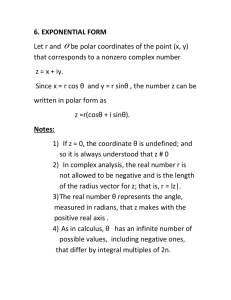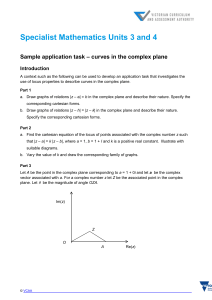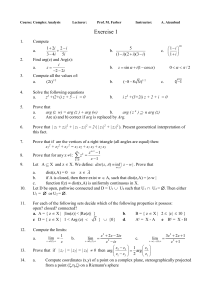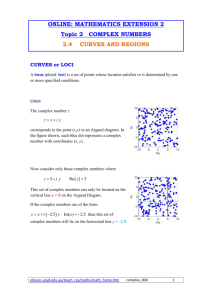complex_002
advertisement
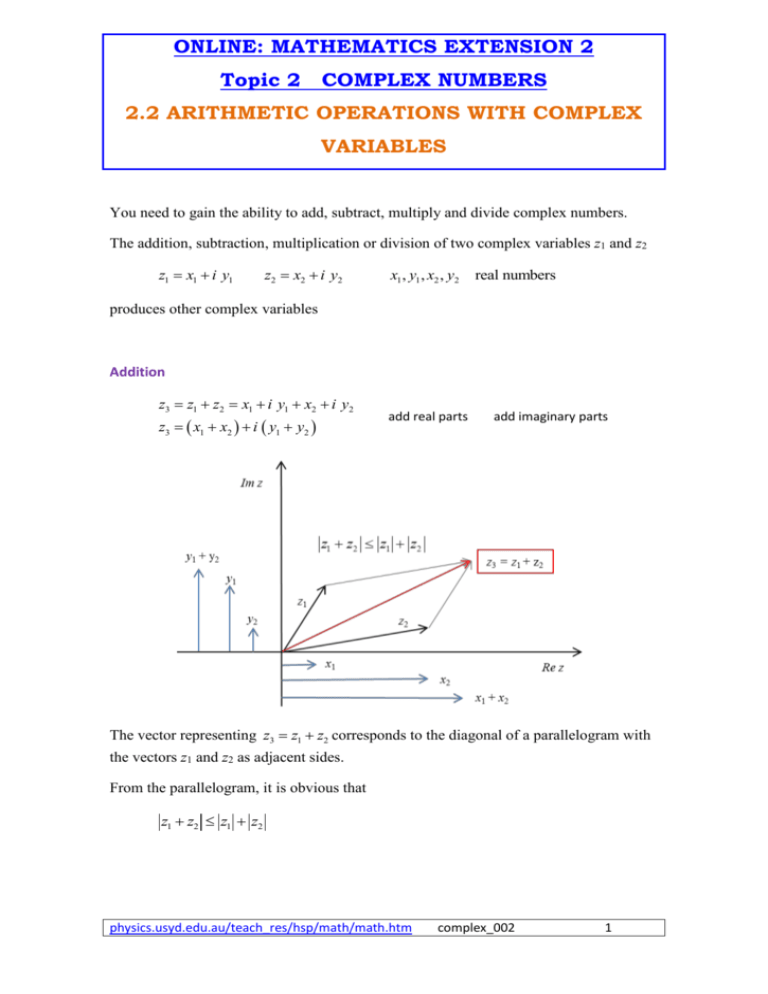
ONLINE: MATHEMATICS EXTENSION 2 Topic 2 COMPLEX NUMBERS 2.2 ARITHMETIC OPERATIONS WITH COMPLEX VARIABLES You need to gain the ability to add, subtract, multiply and divide complex numbers. The addition, subtraction, multiplication or division of two complex variables z1 and z2 z1 x1 i y1 z2 x2 i y2 x1 , y1 , x2 , y2 real numbers produces other complex variables Addition z3 z1 z2 x1 i y1 x2 i y2 z3 x1 x2 i y1 y2 add real parts add imaginary parts The vector representing z3 z1 z2 corresponds to the diagonal of a parallelogram with the vectors z1 and z2 as adjacent sides. From the parallelogram, it is obvious that z1 z2 z1 z2 physics.usyd.edu.au/teach_res/hsp/math/math.htm complex_002 1 Subtraction z4 z1 z2 x1 i y1 x2 i y2 z4 x1 x2 i y1 y2 subtract real parts subtract imaginary parts For subtraction using the Argand diagram simply add the vectors z1 and -z2 z4 z1 z2 z1 z2 Multiplication z5 z1 z2 x1 i y1 x2 i y2 x1 x2 y1 y2 i x1 y2 x2 y1 Division z6 z1 z1 z2 z2 z2 z2 Multiply both the numerator and denominator by the complex conjugate of the denominator so that you are now dividing by the real number z2 z2 . physics.usyd.edu.au/teach_res/hsp/math/math.htm complex_002 2 Multiplication or division of two complex numbers is accomplished most easily when they are in exponential form. z5 z1 z2 R1 ei 1 R2 ei 2 R1 R2 ei 1 2 R1 R2 1 2 R1 R2 cos 1 2 i sin 1 2 z1 R1 i 1 2 R1 e 1 2 z2 R2 R2 R1 R2 cos 1 2 i sin 1 2 z6 A complex number can be shown as a vector on an Argard diagram. z1 x1 i y1 R1 e i 1 R 1 x12 y12 tan 1 y1 x1 We will consider the result of multiplying the complex number z1 by the complex number e i z e i R1 e i 1 R1 e i 1 This means that the vector for z1 is rotated anticlockwise about the origin through an angle to produce the vector for the new vector z. physics.usyd.edu.au/teach_res/hsp/math/math.htm complex_002 3 z e i z1 R1 e i 1 R1 e i 1 Let z1 3 e 4 3 cos i sin 2.1213 1 i 4 4 i i 6 z 3 e 6 4 3 e i 5 12 0.7765 i 2.8978 cos i sin 3 e 2 2 2.1213 i 2.1213 i 3 e i i 2 z e 2 3e 4 z z i i 4 4 Multiplication by i produces an anticlockwise rotation by ( / 2) rad. cos i sin 3 e 2.1213 i 2.1213 z 3 e z z z e i 3e 4 i i i 4 4 1 3 e 3e z e 3e z e 3 2 z e i 2 i i 3 i 2 i 2 i 2 4 4 4 i z cos i sin 3 e 4 2 2 z i 3 e 4 2.1213 i 2.1213 i Clockwise rotation of z1 through ( / 2) rad. physics.usyd.edu.au/teach_res/hsp/math/math.htm complex_002 4 Example Consider the two vectors z1 2 2 i Find z2 3 i z z1 z2 z z1 z2 2 3 2 1 i 3.7321 3.0000 i Find the magnitudes and arguments of z1, z2 and z z xi y Know z R x2 y2 2 Arg ( z ) 1 a tan 0.7854 rad 45o 2 z1 R1 22 22 2.8284 z2 R2 y Arg ( z ) a tan x 1 o Arg ( z ) 2 a tan 0.5236 rad 30 3 3 12 2.0000 3 o Arg ( z ) a tan 0.6771 rad 38.7940 3.7321 z R 3.73212 32 4.7883 Find z z1 z2 z1 2 x 2 i 3xi z2 z z1 z2 z1 z2 2 3 2 1 i 0.28284 1.0000 i z z1 z2 x1 x2 2 y1 y2 2 hence the magnitude of the complex number z1 z2 is equal to the distance between the two points z1(x1, y1) and z2 (x2, y2) on the Argand diagram x1 x2 2 y1 y2 . 2 y2 y1 y2 y1 but is the slope of the line joining x2 x1 x2 x1 the two points z1(x1, y1) and z2 (x2, y2) on the Argand diagram and so, Arg z1 z2 is equal to the angle this line makes with the horizontal Arg z1 z2 atan direction (line parallel to the real axis) as measured in an anticlockwise sense with respect to the horizontal. physics.usyd.edu.au/teach_res/hsp/math/math.htm complex_002 5 Find z z1 z2 z xi y Know z1 x1 i y1 z 2 x2 i y 2 z z1 z2 x1 x2 y1 y2 i x1 y2 x2 y1 z x2 y2 y Arg ( z ) a tan x 3 21 i 21 3 2 1.4641 5.4641 i z 2 z R 1.46412 5.46412 5.6569 5.4641 o Arg ( z ) a tan 1.3090 rad 75 1.4641 Know z R e i R1 e i 1 R2 e i 2 R1 R2 e i 1 2 z 2.8284 2) e i 0.78540.5236 5.6569 e i 1.3090 z R 5.6569 Arg ( z ) 1.3090 rad 75o physics.usyd.edu.au/teach_res/hsp/math/math.htm 75 complex_002 o 45o 30o 6 Find z z1 z2 z xi y Know z z1 x1 i y1 z1 z2 z1 z2 x1 x2 y1 y2 i x1 y2 x2 y1 2 z2 z2 x2 2 y 2 2 z2 y Arg ( z ) a tan x z x2 y2 x1 2 z 2 z 2 x2 i y 2 y1 2 x2 3 3 2 i 2 2 3 4 y2 1 z2 2 1.3660 0.3660 z R 1.36602 0.36602 1.4142 0.3660 o Arg ( z ) a tan 0.2618 rad 15 1.3660 Know z R e i R1 e i 1 R2 e i 2 R1 R2 e R1 2.8284 R2 z i 1 2 1 0.7854 rad = 45o 3 12 2.0000 2 0.5236 rad 30o z1 R1 i 1 2 2.8284 i 0.78540.5236 e 1.4142 e i 0.2618 e z2 R2 2 z R 1.4142 Arg ( z ) 0.2618 rad 15o physics.usyd.edu.au/teach_res/hsp/math/math.htm 15 complex_002 o 45o 30o 7 Modulus and Complex conjugate relationships arg z1 z2 arg z1 arg z2 z1 z2 z1 z2 Proof z1 R1 e i 1 z1 R1 z2 R2 z1 z2 R1 R2 z1 z2 arg z1 1 arg z2 2 z1 z2 R1 e i 1 R2 e i 2 R1 R2 e i 1 2 z2 R2 e i 2 arg z1 z2 1 2 arg z1 arg z2 z arg 1 arg z1 arg z2 z2 z z1 1 z2 z2 Proof z1 R1 e i 1 z1 R1 z z1 R 1 1 z2 R2 z2 z2 R2 arg z1 1 arg z2 2 zn z z1 R1 e i 1 R1 i 1 2 e z2 R2 e i 2 R2 z2 R2 e i 2 z arg 1 1 2 arg z1 arg z2 z2 arg z n n arg z n Proof z Re i z n R ne i n z Rn z n arg z n n n arg z n z1* z2* z1 z2 * z1 z2 * z1* z2* * used for complex conjugate Proof z1 z2 x1 x2 i y1 y2 z1 x1 i y1 z 2 x2 i y 2 z1* x1 i y1 z 2 * x2 i y 2 z1* z2* z1 z2 z1 R1 e i 1 z1 z2 * z1 z2 * x1 x2 i y1 y2 * z1* R1 e i 1 z2 R2 e i 2 z2* R2 e i 1 2 R1R2 e i 1 2 R1 e i 1 R2 e i 1 2 z1* z2* physics.usyd.edu.au/teach_res/hsp/math/math.htm complex_002 8 QUADRATIC FUNCTION A quadratic function has the general form a x2 b x c 0 a0 and its graph is a parabola. If there are real values of x for which the quadratic function a x 2 b x c 0 then the curve will intersect the X axis at the values of x given by the formula x b b 2 4 a c 2a Two real roots when the parabola crosses the X axis twice x1 = 0.5806 x2 = -1.9139 When the parabola touches the X axis at one point, there is only one real root x1 = x2 = -0.6667 The are no real roots when the parabola does not cut the X axis. The two roots are now imaginary x1 = - 0.6667 + i (0.8165) x2 = -1.9139 - i (0.8165) physics.usyd.edu.au/teach_res/hsp/math/math.htm complex_002 9 Example 0ABC is a square on an Argand diagram. The point A is given by the ordered pair (has the ordered 3, 1 . Find the complex numbers for the points B and C. zA xA i yA 3 i z A RA x A2 y A2 2 3 12 2 1 o Arg ( z A ) A a tan 0.5236 rad 30 3 The angle between 0A and OC must be 90o. Multiplication by i produces an anticlockwise rotation of 90o (/2 rad). Therefore, we can determine the coordinates of the point C from zC i z A 1 3 i Hence the order pair for C is 1, 3 or 1, 1.7321 . 2 zC RC xC 2 yC 2 12 3 2 3 Arg ( zC ) C a tan 2.0944 rad 120o 1 0B must correspond to the diagonal of the square whose side length is z RA 2 . Hence, zB RB 22 22 2.8284 The angle between the side 0A and the diagonal OB is 45o (/4 rad). Therefore, B A 45o 30o 45o 1.3090 rad Hence the complex number zB is zB 2.8284 e i 1.3090 xB RB cos 2.8284 cos 1.3090 0.7320 y B RB sin 2.8284 sin 1.3090 2.7320 Hence the order pair for B is 0.7320, 2.7320 . physics.usyd.edu.au/teach_res/hsp/math/math.htm complex_002 10 The square is now rotated about O through an angle of 60o ( / 3 rad) in a clockwise direction. Find the ordered pairs for the vertices of the square A1, B1 and C1. know multiplication of a complex number z by the complex number e i 3 corresponds to a rotation of the vector representing z on an Argand diagram through an angle ( / 3) rad in a clockwise direction. z1 e i 3 ze i 3 R e i R e i 3 The new vertices of the square A1, B1 and C1 are determined by the rotation of the vectors representing zA, zB and zC by ( / 3) rad z A1 RA e zB1 RB e zC1 RC e i A 3 2e i B 3 i C 3 i 0.5236 3 i 1.3090 3 2.8284 e 2e 2 e i 0.5236 i 2.0944 3 2.8284 e i 0.2618 2 e i 1.0472 A1 0.5236 rad 30o B1 0.2618 rad 15o C1 1.0472 rad 60o know The rectangular form of the complex numbers is found from x R cos y R sin x A1 2 cos 0.5236 1.7320 y A1 2 sin 0.5236 1.0000 xB1 2.8284 cos 0.2618 2.7320 xC1 2 cos 1.0472 1.0000 y B1 2.8284 sin 0.2618 0.7320 yC1 2 sin 1.0472 1.7321 The order pairs are A1 (1.7320, -1.0000), B1 (2.7320, 0.7320), C1 (1.0000, 1.7321). rotation by 60o clockwise physics.usyd.edu.au/teach_res/hsp/math/math.htm complex_002 11
